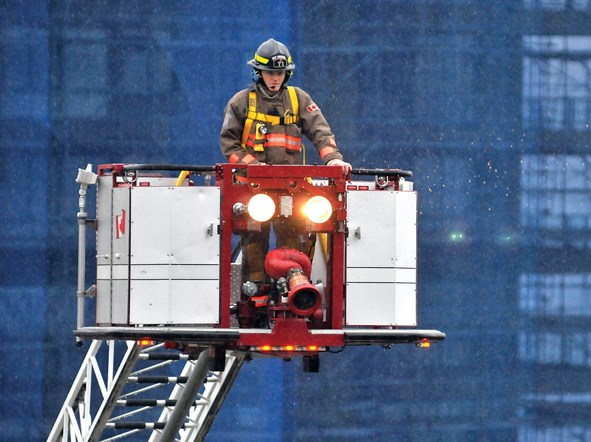In a soon-to-be demolished building along Marine Drive, members of West Vancouver Fire and Rescue Services dart up and down smoke filled corridors, dragging a hose up a flight of stairs while preparing to rescue a trapped individual on another floor.
The building is vacant, but it’s still a challenge for firefighters to manoeuvre and see more than a metre in front of them due to the thick smoke.
A sophisticated instrument called a thermal imaging camera is deployed at one point in order to detect a body through a heavy outpouring of smoke that’s coming from an open apartment door. It’s the kind of device that in the hands of a trained firefighter can mean the difference between saving a trapped inhabitant or not.
All the while, the pounding ring of dozens of fire alarms adds to a sense of chaos and danger – though this time, luckily, the danger’s not real and the stakes aren’t so high.
Since Feb. 10, West Vancouver’s fire department has been running intense simulations and training exercises like this at the old Seaview Gardens building at 2290 Marine Dr.
The site’s developer, Cressey Development Group, has given the fire department the go-ahead to use the vacant six-storey, 47-unit building as a true-to-life training ground before its scheduled demolition on March 1.
“It’s as real to real-life as we could get,” said West Vancouver fire Assistant Chief Jeff Bush. “It’s very, very difficult to simulate something like that unless we’re actually doing it. For us to get to where we can actually do the actual work as opposed to simulating it is invaluable for us.”
The training exercises have included everything from forced door entry, manoeuvring through building obstacles, rescuing trapped inhabitants, and door and lobby control, a method that allows firefighters to limit a fire’s spread by controlling the flow of oxygen.
The department already does many simulations like these in its own fire hall and, when it can, gets access to occupied buildings or even single-family residences for training purposes.
But using Cressey’s vacant building has provided them with an unparalleled environment to practise high-rise fire scenarios in a realistic setting, an important part of the job due to West Vancouver’s large per capita number of highrise buildings.
“We have an extremely high density of highrises for the size of our community,” Bush said. “The potential for hazard or high-risk is definitely very high.”
The department’s deputy chief, Tony D’Angelo, added that being able to do simulations in a vacant building allows them to take their exercises to another level.
“Normally, if there’s people living, here we couldn’t disrupt their lives to this degree. We can take this simulation much further than a routine false alarm,” D’Angelo said.
Since the fire department started officially training at the vacant site, which sits at the corner of Bellevue Avenue and 23rd Street in West Vancouver, the 96 members of the department and some recent recruits have been given the opportunity to participate in the simulations.
Besides pumping the building full of non-toxic “movie smoke” to mimic the conditions of a real fire, Cressey has also given the department permission to use functioning water hoses in the building in order to practise using live water in the context of an intense highrise fire.
A stretch of hallway and stairwell was soaked with water as firefighters navigated parts of the building, dragging the heavy, difficult to manipulate hose through a narrow network of steps, doors and other obstructions.
The department’s Assistant Chief Jay Brownlee, who is also in charge of training, said they often get permission from building management companies to perform exercises in occupied buildings, such as one consistent site at 2020 Bellevue Ave., but having almost total access to a building has added a level of realism that’s much appreciated.
“This is a huge opportunity and Cressey’s been fantastic to allow us to do this because we just simply cannot replicate it as we’re doing here,” Brownlee said.



